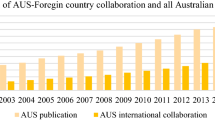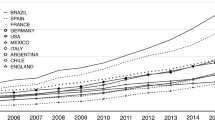Abstract
Faced with limited resources, scientists from around the world enter into collaborations to join their resources to conduct research. Like everywhere else, international co-publishing in southern African countries is increasingly on the rise. The aim of this study was to document and analyse the level of scientific productivity, collaboration patterns, scientists’ experiences and attitudes towards South–South and South–North collaboration. We performed 105 interviews with scientists based at five southern African Universities, namely; University of Malawi—Chancellor College, National University of Science and Technology, the University of Botswana, the University of Zambia, and the University of Zimbabwe. We also traced 192 scientists from the various departments at these universities that had jointly published 623 scientific papers in the field of basic sciences in the period 1995–2014 in Web of Science journals. Our results show that in the majority of the cases funding from the North contributed substantially to increased scientific productivity, and international co-authorship. The results also show that collaboration with southern scientists is equally valued as that with northern scientists, but for different reasons. We conclude that supporting international and national collaboration which includes increased scientific mobility, strong scientific groups and networks, are key factors for capacity building of research in southern African Universities.



Similar content being viewed by others
Notes
This continues to be a puzzle. Could this be due to the quality of the research, or simply due to the fact that scientists are more likely to quote similar networks and the African networks are relatively new and/or weaker.
We use a definition of South–South collaboration that is based upon historical, political and economic relationships and related to the perceptions of our informants at the university departments.
South–North collaboration is important because of knowledge exchange and innovation transfer. Also, it has been estimated that more African descent Ph.D.-holders, of which many in field of science, work outside Africa than within Africa (Hassan, 2001). The increased communication between these scientists and scientists in Africa is a large potential and can be very beneficial for capacity building in science in Africa.
This may change in the future following the establishment in 2012 of a second public university, the International University of Science and Technology (BIUST 2015).
Departments of statistics, and biochemistry are included.
The search was conducted on Web of Science# (WoS) within five databases: Science Citation Index Expanded (SCI-EXPANDED), Social Sciences Citation Index (SSCI), Arts and Humanities Citation Index (AandHCI), Conference Proceedings Citation Index- Science (CPCI-S), and Conference Proceedings Citation Index- Social Science and Humanities (CPCI-SSH). In order to identify the papers, we used name of department, name of scientist that we found on university department web pages or identified through interviews, name of the scientists that were found as coauthors and also belonged to the targeted departments. The type of data we gathered in the WoS search involved year of publishing, authorship position, and coauthor’s institutional belonging.
OECD list of ODA recipients effective for reporting on 2014, 2015 and 2016 flows. Available at: http://www.oecd.org/dac/stats/documentupload/DAC%20List%20of%20ODA%20Recipients%202,014%20final.pdf.
The reasons for low share of papers reaching international journals might be low research quality, local focus of the research, as well as hard access to the journals. It could also be due to the fact that some of the journals are not indexed in web of science and so these papers do not show up in the search.
International Science Programme at Uppsala University, Sweden.
The respondents were free to list more reasons.
National collaboration includes all national scientific institutions and organizations (such as hospitals, NGOs, other universities and research centers), but not the University of the author. The reason for this is that we want to see how strong the inter-institutional networks within the country are.
United States of America.
Some of the donors come from UK, Sweden, Norway, Denmark, US, EU, Germany, Italy, Saudi Arabia, and African Union.
The funding is not the only factor that might influence the productivity. The age, title, ability to network are other factors that can be looked at.
References
Adams, J., Gurney, K., Hook, D., & Leydesdorff, L. (2014). International collaboration clusters in Africa. Scientometrics, 98, 547–556.
Akakandelwa, A. (2009). Author collaboration and productivity at the University of Zambia, 2002–2007. African Journal of Library, Archives and Information Science, 19(1), 13–23.
Alexander, J., & McGregor, J. (2013). Introduction: Politics, patronage and violence in Zimbabwe. Journal of Southern African Studies, 39(4), 749–763. doi:10.1080/03057070.2013.862100.
AU (African Union). (2005). Africa’s science and technology plan of action. South Africa, Johannesburg: African Union.
BIUST (Botswana International University of Science and Technology). (2015). Botswana International University of Science and Technology: History. Resource document. http://www.biust.ac.bw/index.php/about-biust/about-us/history. Accessed April 2015.
Bloom, D.B., Canning, D., Chan, K. (2006). Higher education and economic development in Africa. Cambridge: Harvard University Press.
Boshoff, N. (2010). Cross-national higher education performance indicators, ISI publication output figures for 16 selected African universities. Wynberg: Higher Education Research and Advocacy Network in Africa.
Chandiwana, S., & Ornbjerg, N. (2003). Review of North–South and South–South cooperation and conditions necessary to sustain research capability in developing countries. Journal of Health, Population and Nutrition, 21(3), 288–297.
Gaillard, J. (2010). Measuring research and development in developing countries: Main characteristics and implications for the Frascati manual. Science Technology & Society, 15(1), 77–111.
Gaillard, J., & Furo-Tullberg, A. (2001). Questionnaire survey of African scientists. Stockholm: International Foundation for Science.
GHA (Global Humanitarian Assistance). (2015). Global Humanitarian Assistance, overview of Zimbabwe’s top ten government donors of humanitarian assistance. Source document. http://www.globalhumanitarianassistance.org/countryprofile/zimbabwe#tab-donors. Accessed April 2015.
Hassan, M. H. A. (2001). Can science save Africa? Science, 292(5522), 1609.
HERANA (Higher Education Research and Advocacy Network in Africa). (2013). Programme on Innovation, Higher Education and Research for Development. Wynberg: Higher Education Research and Advocacy Network in Africa.
Holland, D. G. (2010). Waves of educational model production: The case of higher education instituonalizaton in Malawi 1964–2004. Comparative Education Review, 54(2), 199–222.
Kelly, M. J. (1991). The financing of education in Zambia. Paris: International Institute for Educational Planning.
Ki-Moon, B. (2014). The Secretary General’s message on the United Nations Day for South–South cooperation on September 12. Source document. http://ssc.undp.org/content/dam/ssc/documents/news/2014/Ban%20Ki-moon%20South-South%20Day%202014.pdf. Accessed April 13, 2015.
Kumar, V. (2009). Challenges and constrains in South-South collaboration: The experience of AFASSA. In C. Kiselman (Ed.), Proceedings of the International Conference on Regional and Institutional Cooperation to Strengthen Basic Sciences in Developing Countries. Addis Ababa. 1–4 September 2009.
Laudel, G. (2002). What do we measure by co-authorships? Research Evaluation, 11, 3–15.
Lemarchand, G. A., & Schneegans, S. (2014a). Mapping research and innovation in the Republic of Zimbabwe. GO SPIN country profiles in science, technology and innovation policy (Vol. 2). Paris: United Nations Educational, Scientific and Cultural Organization.
Lemarchand, G. A., & Schneegans, S. (2014b). Mapping research and innovation in the Republic of Malawi. GO SPIN country profiles in science, technology and innovation policy (Vol. 3). Paris: United Nations Educational, Scientific and Cultural Organization.
Lemarchand, G. A., & Schneegans, S. (2014c). Mapping research and innovation in Botswana. GO SPIN country profiles in science, technology and innovation policy (Vol. 1). Paris: United Nations Educational, Scientific and Cultural Organization.
Macmillan, H. (2014). The University of Zambia and the liberation of Southern Africa, 1966–90. Journal of Southern African Studies, 40(5), 943–959. doi:10.1080/03057070.2014.946216.
Masaiti, G. (2013). Students’ perceptions of financing public universities in Zambia: Toward a more sustainable and inclusive policy strategy. In D. Teferra (Ed.), Funding higher education in sub-Sahara Africa (pp. 296–326). London: Palgrave Macmillan.
Masaiti, G., & Shen, H. (2013). Cost sharing in Zambia’s public universities: Prospects and challenges. European Journal of Educational Research, 2(1), 1–15.
Melin, G., & Persson, O. (1996). Studying research collaboration using co-authorships. Scientometrics, 36, 363–377.
Menigbeto, E. (2013). Scientific publishing in West Africa: Comparing Benin with Ghana and Senegal. Scientometrics, 95, 1113–1139.
MEPIP (Ministry of Economic Planning & Investment Promotion). (2011). Zimbabwe’s medium term plan 2011–2015. Ministry of economic planning & investment promotion. Harare: Republic of Zimbabwe.
MESVTEE (Ministry of Education, Science, Vocational Training and Early Education). (2015). Education for all 2015 national review. Lusaka: Ministry of Education, Science, Vocational Training and Early Education.
Molutsi, P., & Kagiso, K. (2008). Botswana. In D. Teferra & J. Knight (Eds.), Higher education in Africa—The international dimension (pp. 100–127). Ghana: Association of African Universities.
Murenzi, R. (2013). Foreword. In A. Gurib-Fakim & J. Eloff (Eds.), Chemistry for sustainable development in Africa (pp. v–viii). Berlin: Springer.
OECD (The Organisation for Economic Co-operation and Development webpage). (2015). The Organisation for Economic Co-operation and Development webpage, DAC list of ODA recipients. Source document. http://www.oecd.org/dac/stats/documentupload/DAC%20List%20used%20for%202012%20and%202013%20flows.pdf. Accessed September 2015.
Onana, C. A., Oyewole, O. B., Teferra, D., Beneitone, P., González, J., & Wagenaar, R. (2014). Tuning and harmonisation of higher education: The African experience. Bilbao: University of Deusto.
Pillay, P. (2010). Higher education and economic development, literature review. South Africa, Wynberg: Centre for Higher Education Transformation (CHET).
Pouris, A. (2010). A scientometric assessment of the Southern Africa Development Community: Science in the tip of Africa. Scientometrics, 85, 145–154.
Pouris, A., & Ho, Y. S. (2014). Research emphasis and collaboration in Africa. Scientometrics, 98, 2169–2185.
Sahlin, K. (2011). Preface. In C. Kiselman (Ed.), Regional and interregional cooperation to strengthen basic sciences in developing countries (pp. 9–10). Uppsala: Uppsala University.
Shrum, W. (2007). Structures of scientific collaboration. Cambridge, MA: MIT Press.
Shrum, W., & Campion, P. C. (2000). Are scientists in developing countries isolated? Science Technology & Society, 5(1), 1–34.
Shumba, A., & Mawere, D. (2012). The causes and impact of the brain drain in institutions of higher learning in Zimbabwe. International Migration. doi:10.1111/j.1468-2435.2012.00749.x.
Teferra, D. (2014). Charting African higher education-perspectives at a glance. International Journal of African Higher Education, 1(1), 9–21.
Teferra, D., & Altbach, P. G. (2004). African higher education: challenges for the 21st century. Higher Education, 47(1), 21–50.
The World Bank. (1991). The African capacity building initiative: Toward improved policy analysis and development management. Washington, DC: World Bank.
The World Bank. (2015). Population total. Source document. http://data.worldbank.org/indicator/SP.POP.TOTL. Accessed April 2015.
The World Bank and Elsevier. (2014). A decade of development in sub-Saharan African science, technology, engineering and mathematics research. Source document. www.wds.worldbank.org/external/default/WDSContentServer/WDSP/IB/2014/09/26/000456286_20140926094154/Rendered/PDF/910160WP0P126900disclose09026020140.pdf. Accessed September 2015.
Tijssen, R. J. W. (2007). Africa’s contribution to the worldwide research literature: New analytical perspectives, trends, and performance indicators. Scientometrics, 71(2), 303–327.
Tilley, H. (2011). Africa as a living laboratory: Empire, development, and the problem of scientific knowledge, 1870–1950. Chicago: University of Chicago Press.
Tousignant, N. (2013). Broken tempos: Of means and memory in a Senegalese University Laboratory. Social Studies of Science, 43(5), 729–753.
UB (University of Botswana). (2015). University of Botswana website: Vision, mission and values. Source document. http://www.ub.bw/content/id/2167/Vision,-Mission-and-Values/. Accessed April 2015.
UNESCO (United Nations Educational, Scientific and Cultural Organization). (2010). UNESCO science report 2010. Paris: United Nations Educational, Scientific and Cultural Organization.
UNESCO (United Nations Educational, Scientific and Cultural Organization). (2015a). United Nations Educational Scientific and Cultural Organization webpage: Country profile of Botswana. Source document. http://en.unesco.org/countries/botswana. Accessed April 2015.
UNESCO (United Nations Educational, Scientific and Cultural Organization). (2015b). United Nations Educational Scientific and Cultural Organization webpage: Country profile of Zambia. Source document. http://en.unesco.org/countries/zambia. Accessed April 2015.
Waast, R., & Krishna, V. V. (2003). The status of science in Africa. Science, Technology & Society, 8(2), 145–152.
Wendland, C. L. (2012). Moral maps and medical imaginaries: Clinical tourism at Malawi’s College of Medicine. American Anthropologist, 114(1), 108–122.
Zink, E., & Gaillard, J. (2006). Summary of IFS impact studies nos. 1–5. International Foundation for Science (IFS): Stockholm.
Zink, E. (2013). Hot science and high water: Assembling nature, society and environmental policy in contemporary Vietnam. Copenhagen: NIAS Press.
Author information
Authors and Affiliations
Corresponding author
Rights and permissions
About this article
Cite this article
Zdravkovic, M., Chiwona-Karltun, L. & Zink, E. Experiences and perceptions of South–South and North–South scientific collaboration of mathematicians, physicists and chemists from five southern African universities. Scientometrics 108, 717–743 (2016). https://doi.org/10.1007/s11192-016-1989-z
Received:
Published:
Issue Date:
DOI: https://doi.org/10.1007/s11192-016-1989-z




